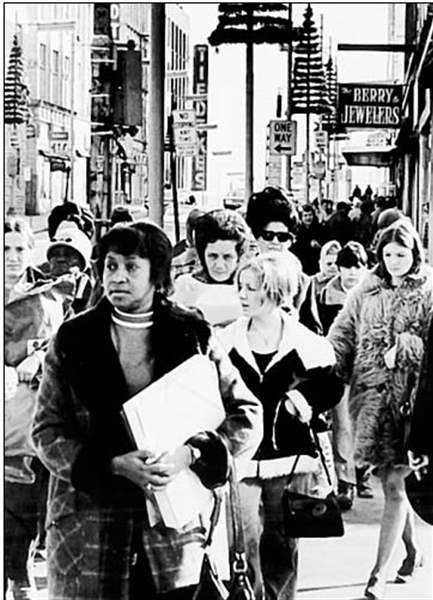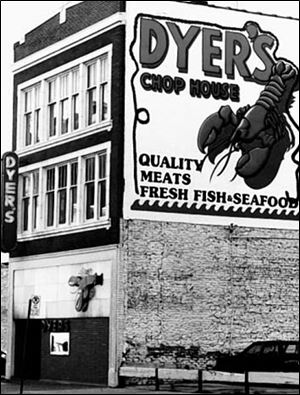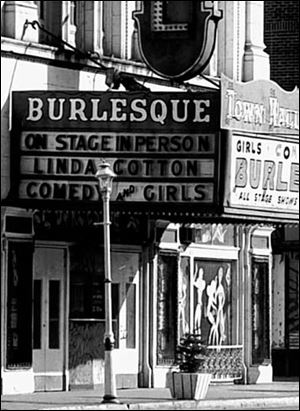
DOWN BUT NOT OUT
Downtown Toledo teemed with activity into the '70s
6/22/2008
Christmas shoppers found plenty of stores open in downtown Toledo in the days before malls opened.

Christmas shoppers found plenty of stores open in downtown Toledo in the days before malls opened.
Just a generation or so ago, in the 1970s, Toledo's downtown was beyond its peak. But there were still plenty of signs of life: Crowds of workers and shoppers, large corporate headquarters, eight locally owned financial institutions, busy hotels, a vibrant night life, and restaurants galore.
There was something for everybody. There was a critical mass of the stuff it takes to make a downtown real - and exciting.
"Everything was bustling in downtown Toledo in the early 1970s," recalled Larry Boyer, who managed and lived in the old Willard Motor Lodge and its successor, the Renaissance Hotel, for nearly a decade.
"You didn't have to leave for anything except groceries," said Mr. Boyer, now a banker and one of the founders of Waterford Bank in Sylvania Township. "Everything else was there - big department stores, the soda fountain at Woolworth's, shopping at night, people on the streets.
"I could walk around after work and go to the Quarterdeck Lounge [at the Commodore Perry Motor Inn] or the Top of the Tower [on the 30th floor] at Fiberglas Tower. It was really something special. I had a great time downtown."
Another banker, John Szuch, said, "There was much more of a financial feel to the downtown [in the 1970s]. Everybody was downtown, including probably 10 to 12 brokerages." Mr. Szuch, who was with the old Toledo Trust Co. in the 1970s, is chairman of Fifth Third Bank (Northwestern Ohio).
READ MORE: Down But Not Out series
Among the downtown brokerages in the 1970s were two local ones that held seats on the New York Stock exchange and produced stock offerings for area corporations: the former Bell & Beckwith and Foster Bros., Weber & Co.
Locally owned banks were Toledo Trust, First National Bank of Toledo, Ohio Citizens Trust Co., and Mid American National Bank & Trust Co., and there were also four local thrifts: First Federal Savings and Loan Association, People's Savings, United Savings & Loan Association, and Toledo Home Federal Savings & Loan Association. All were later acquired and are now part of larger banks in Cleveland, Columbus, and Cincinnati.
In those days, seven Fortune 500 companies had their headquarters in Toledo (just two remain here today) and five were within a few blocks of each other downtown: Owens-Illinois Inc., Owens Corning, Libbey-Owens-Ford Co., Sheller-Globe Corp., and Questor Corp. OC is the only one still downtown.
Even as late as the mid-1970s, there were still four new-car dealerships in or near the downtown. Downtown hotels of that era included the elegant Commodore Perry, the Hillcrest, the Waldorf, and the Holiday Inn Downtown.
By some estimates, the number of downtown workers peaked at 40,000-plus in the early 1950s, but 31,000 downtown jobs remained in the late 1970s, dropping to 25,000 by the late 1980s, and to fewer than 20,000 in the private sector today.
Those workers of a generation ago supported a thriving environment for dining and entertainment.

Dyer s Chop House on Superior Street placed live lobsters in its front window to showcase seafood as its specialty.
"I remember that the Toledo Club was always busy," said Wallen "Buzz" Crane, who managed several downtown brokerages in the 1970s. "There were times when you couldn't get seated for lunch, and it was a more elite establishment [then]." He is now senior vice president for Smith Barney in this area.
Popular restaurants included the Wheel, the Swivel Chair, the City Club, the Court House Bar, Kewpee's, Greunke's Cafeteria, Eppes Essen, Posner's, and Dyer's Chop House. Dyer's was particularly memorable because of its lobsters on display inside its front window and the fact that it was a "men only" restaurant for lunch until a federal judge ordered it opened to women in 1972.
Many former Toledoans have fond memories of the White Tower restaurants downtown. Among them is former radio disk jockey Chris Loop, who now lives in Naples, Fla. "I guess we knew we had 'made it' when we got quick service at the White Tower across from the WIOT station. Without their famed 'Butter Burgers' I don't know if we could have made it as far as we did."
Among the downtown watering holes, said Bob McCarthy, a marketing man who was sales manager for the Holiday Inn Downtown during much of the 1970s, were the Town Club, Quarterdeck Lounge, Jim Feak's, Zorba's Supper Club, and the Driftwood. In the early 1970s, the Press Club of Toledo opened in the basement of the former Willard Hotel, where it had its own bar and restaurant.
Carol Eggerstorfer Mancy, who managed the Press Club in the late 1970s, remembers it as "the place to be for lunch." It had more than 700 members.
The downtown had dozens of taverns but probably none more colorful than the Jackson Bar, at the corner of Jackson and Superior streets. That bar attracted a diverse crowd, including sailors, police officers, politicians, pool shooters, and strippers (Toledo still had two burlesque theaters, the Town Hall and the Esquire, in the 1970s).
One of downtown's bars achieved national fame without ever being mentioned, by name, in Kenny Rogers' monster 1970s hit "Lucille." That song, written by Hal Bynum and Roger Bowling, was inspired by an actual encounter in the Country Palace, known forever as "a bar in Toledo across from the depot." The "depot" was the Greyhound bus station on Jefferson Avenue.
Among the many downtown bars was the Hustler Lounge, one of the first opened by Larry Flynt on his way to bigger fame as the publisher of Hustler magazine. Downtown Toledo also had numerous strip joints in the 1970s.
In the days before suburban malls, downtown was the place to shop. It had the Lion Store, Lasalle's (Macy's), Lamson's, and Tiedtke's department stores; the men's stores of B.R. Baker, Damschroder's, H.O. Nichols, Bond's, and Jack's Mens Shop, and the women's stores of Petrie's and Stein's. There also were many shoe stores.

The Town Hall Theater was one of two burlesque showplaces remaining in downtown Toledo in the 1970s.
By 1973, Toledo had four suburban malls, including Franklin Park, "and that took retail out of the downtown," said Michael Young, a former Toledo-Lucas County planner, now senior planner for Rick Urban Design & Planning in San Diego.
By the mid-1970s, Tiedtke's and Lamson's were gone, the Lion Store closed in 1980, and Lasalle's shut its doors in 1984.
But the downtown also suffered from other factors, such as the outflow of businesses to suburban locations such as Maumee's Arrowhead Park beginning in the late 1970s, and the corporate takeovers and downsizings beginning in the 1980s.
"I seriously doubt that I will ever see a rebirth of downtown," Mr. McCarthy lamented. "The corporate community just isn't there, and retail isn't there either. Oh, we'll see hot spots like the ballpark and the arena, plus whatever springs up in that area, but a downtown like the old days, no way."
Mr. Young disagreed.
"Downtowns decline slowly, and they also rise slowly," he said. "The real key to revitalizing a downtown is stabilizing its edges and reanimating the surrounding neighborhoods. Reintroduce the downtown to people who lost touch with it."
Contact Homer Brickey at:
homerbrickey@theblade.com
or 419-724-6129.